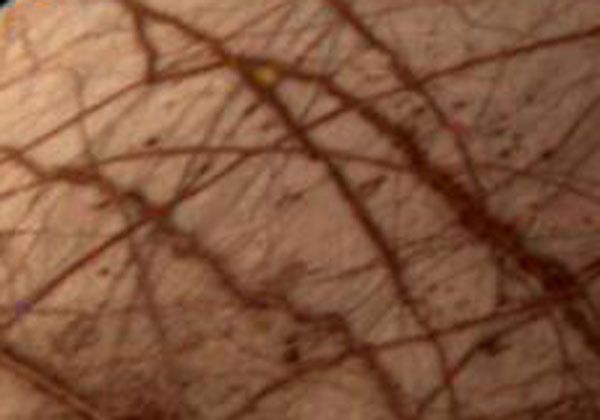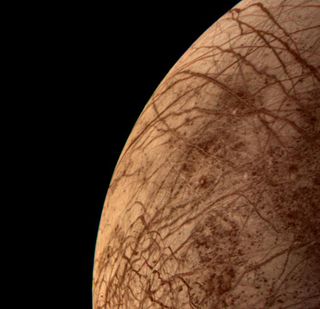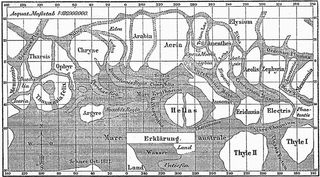What the Heck Is This?

Giovanni Schiaparelli never saw these, but if he had, he might've called them canali. Yeah, that was a hint.
But I figure this one will be real hard, so (SPOILER ALERT) here are a couple more really good hints: This photograph was taken by the Voyager 2 space probe on July 9, 1979. It is not the surface of a planet.
See the full image below and read about the image … and how Schiaparelli has nothing to do with it.
It's a photo of Jupiter's moon Europa, which is about the same size as our moon. Scientists figure Europa has an outer shell of ice that's about 62 miles (100 km) thick, with a liquid ocean below. The streaks are created when the crust fractures and stuff from below oozes out.
The absence of impact craters suggests the crust is relatively fresh, being replenishing constantly and erasing the evidence of impacts that surely must occur. So what was that nonsense about Schiaparelli? Read on ...

The Schiaparelli connection
In late 1877, the colorblind but sharp-eyed Italian astronomer was checking out Mars through an 8.75-inch (0.2-meters) telescope. He drew what he saw, and called his squiggles canali, an Italian word meaning channels. Here's what happened next:
Sign up for the Live Science daily newsletter now
Get the world’s most fascinating discoveries delivered straight to your inbox.
The word was inaccurately translated to "canals" in English. Some historians think the goof was fueled by excitement over the construction of the Suez Canal, an engineering marvel of the era completed in 1869. And then ...

Then, in the early 1900s, U.S. astronomer Percival Lowell observed the same apparent streaks n Mars, which connected dark areas thought to be oases, and determined they were canals built by intelligent beings to irrigate the desert planet with water from the polar caps. Lowell presented his first drawings in an 1895 book titled "Mars." He argued his full theory in a 1908 book, "Mars as the Abode of Life." Many newspaper editors of the time defended him, even though other astronomers withheld judgment.
In hindsight, Lowell's claims of intelligent life on Mars were outlandishly speculative. But his conclusions joined a chorus of false impressions about Mars that predated him by centuries and lasted well beyond his death in 1916.
As late as 1924, earthlings listened for radio signals from Mars -- at the request of the U.S. government. And in 1938 Orson Welles' radio antics frightened thousands of listeners into believing Martians had invaded, first targeting New Jersey.
In fact, the canals never existed. Scholars say the canals were the product of a human tendency to see patterns. When looking at a group of dark smudges, the eye will tend to connect them with straight lines.
Imagine if Schiaparelli had seen Europa!
Got a strange or interesting photo related to science, nature or technology? What the Heck, send it to me, and maybe I'll use it.
Robert is an independent health and science journalist and writer based in Phoenix, Arizona. He is a former editor-in-chief of Live Science with over 20 years of experience as a reporter and editor. He has worked on websites such as Space.com and Tom's Guide, and is a contributor on Medium, covering how we age and how to optimize the mind and body through time. He has a journalism degree from Humboldt State University in California.











